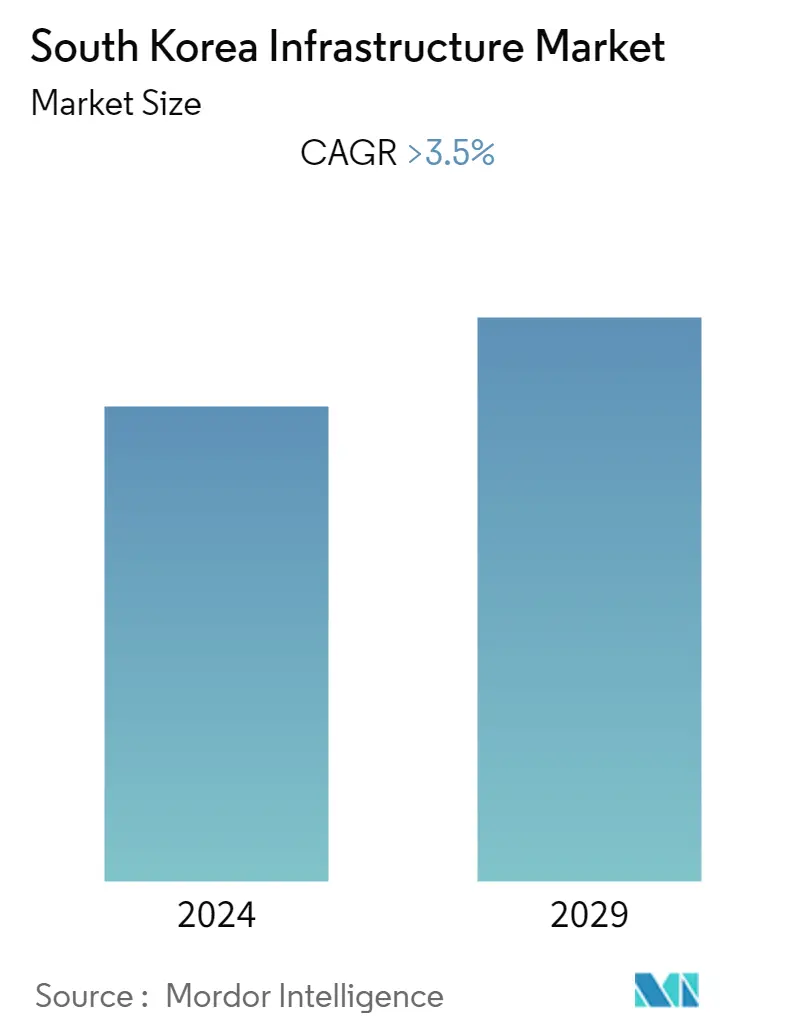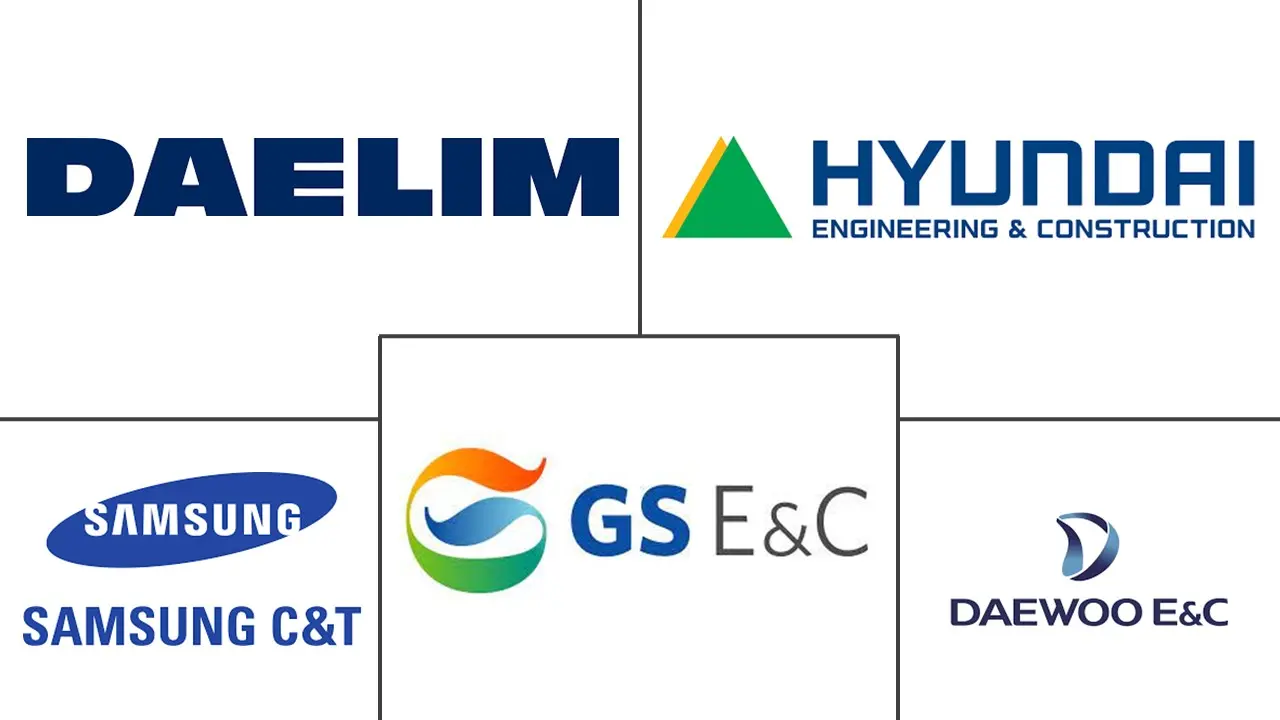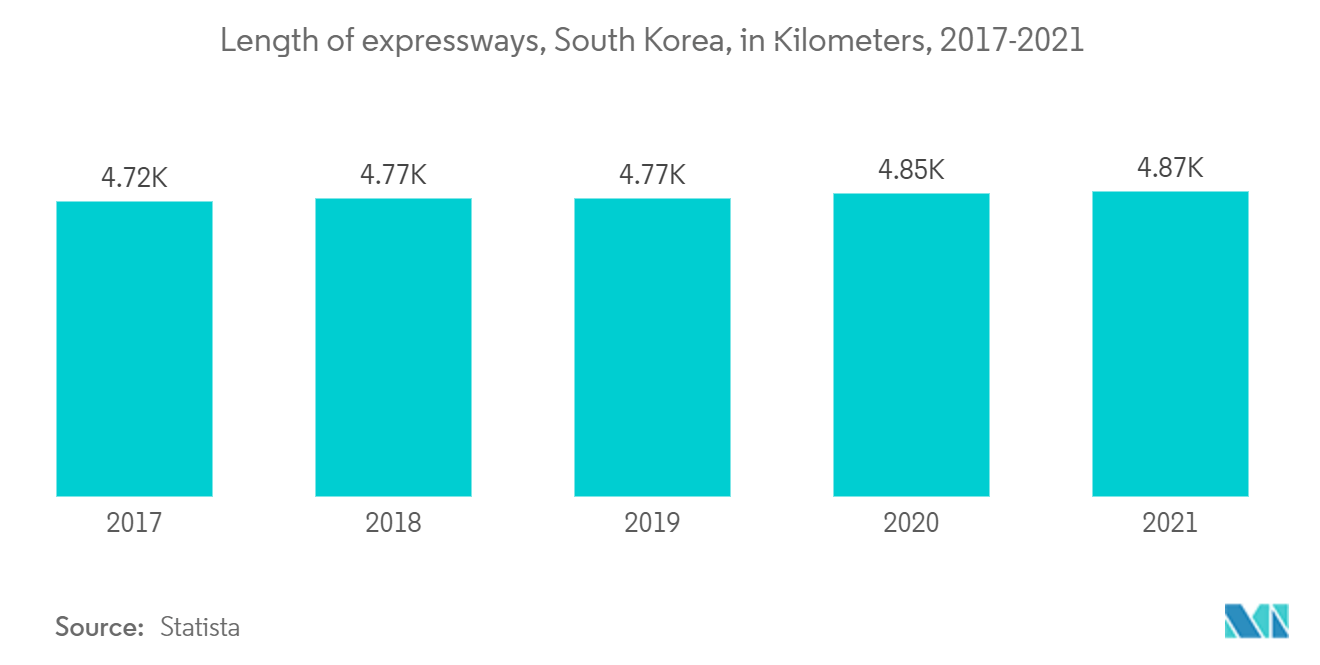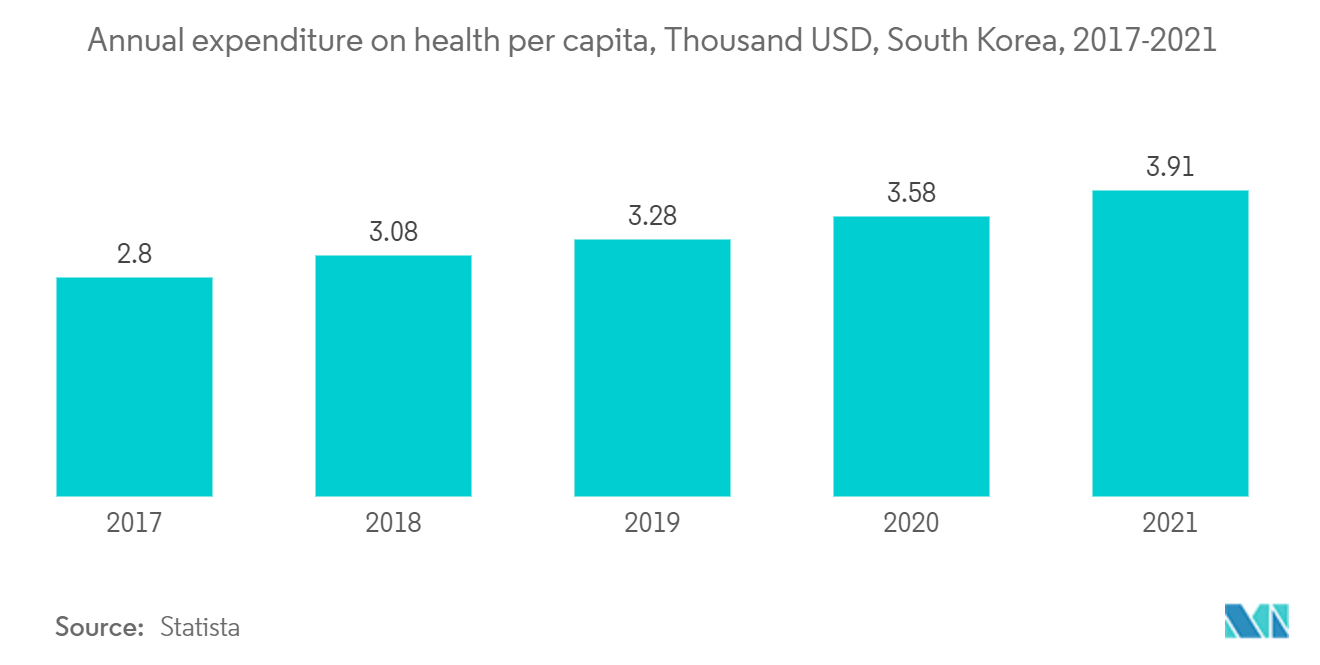South Korea Infrastructure Market Size

| Study Period | 2020 - 2029 |
| Base Year For Estimation | 2023 |
| Forecast Data Period | 2024 - 2029 |
| Historical Data Period | 2020 - 2022 |
| CAGR | 3.50 % |
| Market Concentration | Medium |
Major Players
*Disclaimer: Major Players sorted in no particular order |
South Korea Infrastructure Market Analysis
The size of South Korea's infrastructure market is USD 55.4 billion in the current year and is anticipated to register a CAGR of over 3.5% during the forecast period The huge investments pouring into the country's transportation infrastructure fuelled by manufactured and allied industries drive the market. Furthermore, the market is driven by IT-enabled industries looking forward to advanced infrastructure in the country.
- South Korea is an ideal market for US firms seeking to test cybersecurity solutions before deploying them in other markets due to its leadership in high-speed internet use and advanced ICT infrastructure. While companies that create sophisticated and cutting-edge products for critical infrastructure are more likely to succeed, there are also opportunities for companies that provide cybersecurity consulting and training services. Overall, the Korean market prefers the quality and dependability of American products, and demand for American goods is expected to remain strong. South Korea is developing its AI capabilities and has stated its desire to become a global player in the AI technology markets. ROK officials see AI as a critical component of the country's ICT prowess and are committed to making Korea an AI powerhouse.
- One of the key factors driving the growth of the VDI market in South Korea is the growing need for remote support across various organizations. Remote support software is in high demand due to increasing internet speeds and the need for cost-effective solutions to optimize various business operations. Furthermore, remote support software solutions are more beneficial to businesses that focus on resolving end-user technical issues. Today, a sizable proportion of consumers use solutions for battery optimization, firmware support, and malware detection. Many small businesses are equipping their IT help desks with remote support software to provide technical support to such customers. Essentially, the growing demand for remote support solutions will drive market growth during the forecast period.
- Because of advances in information and communication technology, the mobility sector is undergoing a major transformation. The South Korean government's Ministry of Land, Infrastructure, and Transport has unveiled the "Mobility Innovation Roadmap" to establish its leadership in the mobility sector and promote innovative services. The ministry formed the 'Mobility Innovation Committee,' which is made up of private-sector experts working solely in the fields of transportation, consumer, and information technology. The ministry intends to expand and reorganize the Mobility Innovation Committee into a public-private joint organization to ensure the mobility roadmap's smooth implementation, review the roadmap's implementation status, and discuss the discovery of new tasks and the supplementation of existing ones.
- South Korea's exports reached USD 644.5 billion in 2021, the highest ever, thanks to strong sales of major industries and the growth of new industries. Despite COVID-19, Korean firms were able to minimize production disruptions, and major industries such as semiconductors, shipbuilding, and automobiles led the global market in terms of product competitiveness. Cosmetics, agriculture and marine products, and plastics were among the new export industries that saw significant growth. Last year, the top 15 major export items, which included semiconductors, petrochemicals, and automobiles, increased by double digits. It is the first time that all 15 items have increased at the same time. This has been made possible by the country's infrastructure growth, which the country's manufacturing growth has supplemented.
South Korea Infrastructure Market Trends
This section covers the major market trends shaping the South Korea Infrastructure Sector Market according to our research experts:
Investment on transportation infrastructure driving the market
To facilitate the early operation of the high-tech future mobility network, the country intends to overhaul the public transportation system by 2024. South Korea hopes that by 2035, half of all new cars will be fully automated and that traffic-related deaths will be reduced to under 1000 per year. Another important goal is for South Korea to release a Level 3 autonomous car by the end of 2022, making it the third country in the world after Germany and Japan. Autonomous buses will be available on public roads by 2025, and cars will be available by 2027. To accommodate Level 4 automation, the country will also change car insurance, driver's license, and traffic laws. Real-time communication infrastructure will be built on national roads by 2030.
Transport is an essential component of the economy. It makes daily commutes more convenient, allows us to travel freely to all corners of the country, and allows us to receive parcels and other goods in the comfort of our own homes. The transportation and logistics industries are indeed the pillars that support Korea's economy, and new modes of mobility, such as autonomous vehicles and urban air mobility (UAM), are providing new impetus for future growth. The Ministry of Land, Infrastructure, and Transport will work to innovate the entire transportation sector to bring practical improvements to the public's daily lives.
MOLIT will accelerate key transportation projects such as the Great Train eXpress (GTX), metropolitan/high-speed railways, underground expressways, and the new airport in Gadeokdo to address traffic congestion in metropolises and achieve more balanced national growth. To provide consumer-centric services, public transportation will make an innovative shift. MOLIT intends to increase investment in expanding public transportation services and improving intermodal transfer while updating outdated regulations. Efforts will also be made to improve transportation accessibility for vulnerable groups such as the disabled, the elderly, and those living in remote areas. The transportation industry is currently undergoing a period of rapid mobility transformation.

Increased support of health infrastructure driving the market
Samsung Medical Center in South Korea has been working to become an advanced intelligent hospital, becoming the world's first hospital to achieve the highest stage in the HIMSS Infrastructure Adoption Model. A smart hospital of the future will need three things: mass data communication, multi-species and mass device connectivity, and seamless service convergence. Smart parking, medical, incremental location checks, automated medical payment, smart call centre system, automated medical equipment interface, and logistics innovations through robots are among the key projects it sought to implement through this roadmap.
South Korea has a growing need for medical practice digitization and advanced solutions to support a rapidly ageing population, presenting a USD 5 billion-plus market with significant opportunities for Western technology companies. South Korea, with a track record of transforming startups into successful scaleups, also provides numerous opportunities for firms seeking to become world leaders, as well as those seeking strategic investments and global partners. Gaining regulatory approval in the country also opens doors to other east and southeast Asian markets where Korean firms are well-regarded.
Korea's adoption of EMR systems is significantly higher than the OECD average of 81%, reflecting the country's nearly complete digitisation of patient data, digital storage of clinical images, electronic hospital administration databases, and expanding use of remote sensor technology. The government intends to build smart medical infrastructure based on digital technology, highlighting in its Korean New Deal a goal of establishing 18 smart hospitals by 2025 to allow for real-time patient monitoring, diagnosis, and treatment. This means that hospitals will need to implement HIT solutions to fully digitize their operations, creating significant opportunities for international companies with appropriate technologies.

South Korea Infrastructure Industry Overview
The South Korea Infrastructure Sector Market is moderately fragmented due to the presence of local and regional players majorly. The majority of the market is shared by these players, with a few global players entering the market via partnerships and foreign investments. The major players are Samsung C&T, Hyundai E&C, Daelim Industrial, GS E&C, Daewoo E&C, and many more. The players using advanced technology have a great advantage as South Korea is looking forward to such ventures for infrastructure development in the country.
South Korea Infrastructure Market Leaders
-
Samsung C&T
-
Hyundai E&C
-
Daelim Industrial
-
GS E&C
-
Daewoo E&C
*Disclaimer: Major Players sorted in no particular order

South Korea Infrastructure Market News
- October 2022: Keppel Infrastructure, based in Singapore, completed the USD 0.60 billion acquisition of EMK Co., South Korea's leading waste management company. The sale price of approximately 20 times earnings before interest, taxes, depreciation, and amortization (EBITDA) was viewed as excessive by industry sources, despite the waste management company's growth potential, given the recent deterioration in market sentiment due to rising interest rates and other bearish factors.
- September 2022: Hyundai Motor Group (HMG/the Group) will expand its strategic partnership with KT Corporation (KT), Korea's leading telecommunications company, to lead the future mobility market. Hyundai Motor Group announced today that it would push for comprehensive and extensive collaboration in next-generation communication infrastructure and ICT, including joint research with KT on 6G autonomous driving technology and an Advanced Air Mobility (AAM) communication network based on satellite communication.
South Korea Infrastructure Market Report - Table of Contents
1. INTRODUCTION
- 1.1 Study Deliverables
- 1.2 Study Assumptions
- 1.3 Scope of the Study
2. RESEARCH METHODOLOGY
3. EXECUTIVE SUMMARY
4. MARKET INSIGHTS AND DYNAMICS
- 4.1 Current Economic and Construction Market Scenario
- 4.2 Technological Innovations in the industry
- 4.3 Impact of Government Regulations and Initiatives on the Industry
- 4.4 Market Drivers
- 4.5 Market Restraints
-
4.6 Porter's Five Forces
- 4.6.1 Threat of New Entrants
- 4.6.2 Bargaining Power of Buyers/Consumers
- 4.6.3 Bargaining Power of Suppliers
- 4.6.4 Threat of Substitute Products
- 4.6.5 Intensity of Competitive Rivalry
- 4.7 Value Chain / Supply Chain Analysis
- 4.8 Impact of COVID -19 on the Market
5. MARKET SEGMENTATION
-
5.1 By Type
- 5.1.1 Social Infrastructure
- 5.1.1.1 Schools
- 5.1.1.2 Hospitals
- 5.1.1.3 Defence
- 5.1.1.4 Others
- 5.1.2 Transportation Infrastructure
- 5.1.2.1 Railways
- 5.1.2.2 Roadways
- 5.1.2.3 Airports
- 5.1.2.4 Waterways
- 5.1.3 Extraction Infrastructure
- 5.1.3.1 Power Generation
- 5.1.3.2 Electricity Transmission & Disribution
- 5.1.3.3 Water
- 5.1.3.4 Gas
- 5.1.3.5 Telecoms
- 5.1.4 Manufacturing Infrastructure
- 5.1.4.1 Metal and Ore Production
- 5.1.4.2 Petroleum Refining
- 5.1.4.3 Chemical Manufacturing
- 5.1.4.4 Industrial Parks and clusters
- 5.1.4.5 Others
6. COMPETITIVE LANDSCAPE
- 6.1 Market Concentration Overview
-
6.2 Company Profiles
- 6.2.1 Samsung C&T
- 6.2.2 Hyundai E&C
- 6.2.3 Daelim Industrial
- 6.2.4 GS E&C
- 6.2.5 Daewoo E&C
- 6.2.6 POSCO E&C
- 6.2.7 Hyundai Engineering
- 6.2.8 Lotte E&C
- 6.2.9 HDC (Hyundai Development Company)
- 6.2.10 Hoban Construction*
- *List Not Exhaustive
7. MARKET OPPORTUNITIES AND FUTURE TRENDS
8. APPENDIX
** Subject To AvailablitySouth Korea Infrastructure Industry Segmentation
Infrastructure is referred to as the fundamental physical framework of an organization, region, or country. It frequently pertains to the creation of public goods or industrial activities. A complete background analysis of the South Korea Infrastructure Sector Market, including the assessment of the economy and contribution of sectors in the economy, market overview, market size estimation for key segments, and emerging trends in the market segments, market dynamics, and geographical trends, and COVID-19 impact is included in the report.
The South Korea infrastructure sector market is segmented by type (social infrastructure, transportation infrastructure, extraction infrastructure, and manufacturing infrastructure). The report offers market size and forecasts for the South Korea Infrastructure Market in value (USD Billion) for all the above segments.
| By Type | Social Infrastructure | Schools |
| Hospitals | ||
| Defence | ||
| Others | ||
| By Type | Transportation Infrastructure | Railways |
| Roadways | ||
| Airports | ||
| Waterways | ||
| By Type | Extraction Infrastructure | Power Generation |
| Electricity Transmission & Disribution | ||
| Water | ||
| Gas | ||
| Telecoms | ||
| By Type | Manufacturing Infrastructure | Metal and Ore Production |
| Petroleum Refining | ||
| Chemical Manufacturing | ||
| Industrial Parks and clusters | ||
| Others |
South Korea Infrastructure Market Research FAQs
What is the current South Korea Infrastructure Market size?
The South Korea Infrastructure Market is projected to register a CAGR of greater than 3.5% during the forecast period (2024-2029)
Who are the key players in South Korea Infrastructure Market?
Samsung C&T, Hyundai E&C, Daelim Industrial, GS E&C and Daewoo E&C are the major companies operating in the South Korea Infrastructure Market.
What years does this South Korea Infrastructure Market cover?
The report covers the South Korea Infrastructure Market historical market size for years: 2020, 2021, 2022 and 2023. The report also forecasts the South Korea Infrastructure Market size for years: 2024, 2025, 2026, 2027, 2028 and 2029.
Who are the key target audiences for the South Korea Infrastructure Market?
Key target audiences for the South Korea Infrastructure Market include market players, investors, end-users, government authorities, consulting and research firms, venture capitalists, and value-added resellers (VARs).
Which segment of the Infrastructure Market in South Korea is expected to dominate during the forecast period?
The transportation infrastructure segment is expected to dominate the South Korea Infrastructure Market during the forecast period.
South Korea Infrastructure Industry Report
The South Korea Infrastructure Market is on a trajectory of significant growth, fueled by advancements in various sectors, a rising demand for remote support solutions, and substantial investments in transportation infrastructure. This market's expansion is further supported by South Korea's advanced ICT infrastructure and global leadership in high-speed internet, attracting companies specializing in cybersecurity, remote support software, and innovative technical solutions. Key players, including some of South Korea's biggest infrastructure companies, are leveraging their expertise to meet the evolving needs of this dynamic market. Government initiatives aimed at enhancing transportation and health infrastructure are also pivotal in promoting market growth, aiming to improve quality of life and stimulate economic progress. However, the market faces challenges related to data security and privacy concerns. The competitive landscape is characterized by key players focused on technological advancements and strategic partnerships. For detailed statistics on market share, size, revenue growth rate, and a forecast outlook, Mordor Intelligence™ Industry Reports offer comprehensive analysis and insights, available for download as a free report PDF.



